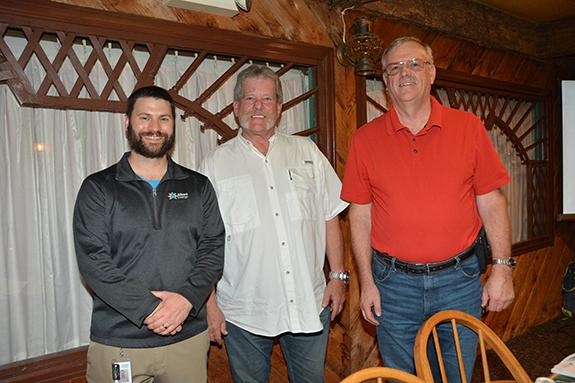Tony Palese, senior communications partner at Alliant Energy, and Rick Nowicki, Site Manager, Alliant Energy, were the guest speakers at the evening Wautoma Kiwanis meeting held at the Silvercryst, Wautoma, on Nov. 3rd. The topic was the update on the Wautoma Solar Farm project.
Nowicki, Wautoma Solar Site Manager, told the group that the Wautoma Solar project is one part of Alliant’s Clean Energy Blueprint and by 2040 they hope to eliminate all coal from their generation fleet. Alliant is the 3rd largest owner-operator of regulated wind energy in the U.S. and will soon be the largest owner-operator of solar in Wisconsin. He added that coal and natural gas are imported and adding solar ensures a diversified mix. He said once solar and wind are on site, maintenance is minimal which reduces long term costs and liability.
The Wautoma Solar project is on 624 acres, and will produce 99 million watts of power and construction will include between 100 and 200 local jobs. Construction began in July and will be fully operational before November of 2023. They are 67% complete on installing 680,322 linear feet of DC cable. They are 86% complete on installing 240,000 linear feet of AC cable. There will be 44,625 piles and 35% are installed. The solar panel modules are 545 watt, roughly 4’x8’ in dimension, weighing 71 lbs. each and generate power from both the front and back sides of the panels as they track the sun. Nowicki said they need to get all the posts and underground wire in before the frost and they will be working on the project throughout the winter.
The panels are expected to produce solar energy for 30 years and they do degrade over time but they retain 85% efficiency. If landowners after the 30 years wish to renew their lease new panels can be installed, or the land can return to farmland.
They stressed using local labor is a priority to keep the construction dollars local and adds to the economy. They are using all local labor except for the supervisory personnel.
Palese was asked if there were any downsides to solar and he explained that solar doesn’t work at night and they are planning to develop battery projects at the company’s Wood County and Grant County solar project sites. Also as far as keeping the sites from having to be mowed and maintained they use a low growth grass and only have to mow twice a year. They also use 5 to 10% pollinator seedlings to attract butterflies and bees. They also stressed that they never haul out any topsoil, it gets put back and seeded.
One of the Kiwanis members asked about the economic impact of the project, said Palese. A recent study by the WI Counties Association and Forward Analytics found that using local workers on solar projects generates between 73% and 158% more economic activity compared to using out-of-state labor. According to the study, a 100% local workforce building a 150 MW solar installation in rural Wisconsin would generate $11.8 million in economic activity in the region. The Wautoma site is about 2/3 the size of the 150MW example used, so the impact would be a bit less than that $11.8M figure, he added. The study also found that average wages paid to union workers on sites like Wautoma generally range from ~$30-$40 per hour (or about $62,000-$83,000/yr assuming 40 hrs/wk).
There was also a question regarding how Alliant arrived at the estimated figure for costs avoided as part of its Clean Energy Blueprint transition. Information Alliant submitted to state regulators showed that their Blueprint plans to accelerate the transition to renewable energy and modernize the grid through technology enhancements would avoid between $1.6 billion to $6.1 billion in long term costs on a nominal basis across five different planning scenarios examined, over a 34-year planning window.
These projections are driven largely by the declining cost of solar, access to federal tax incentives, and the expected costs that would have been incurred to fuel, operate and maintain aging coal facilities in Wisconsin over that timeframe.
Palese also wanted to share the opportunities through the Alliant Energy Foundation. Alliant Foundation staff are always looking for opportunities to partner with community organizations to make a positive impact. From helping with basic food and housing needs to providing targeted support for community events and conservation efforts, there are a wide range of programs and efforts Alliant Energy’s Foundation has sponsored. You can find information about the Foundation’s Community Giving Programs online. If you have ideas on larger projects you’d like to see funded or supported, individuals can explore options through the Foundation’s Impact Grant program which focuses on several core areas: Hunger and Housing, Workforce Readiness, Environmental Stewardship and Diversity, Safety and Well-being.
To keep up on the progress of the Wautoma Solar project contact solar@alliantenergy.com to request a newsletter e-delivery, for more information visit alliantenergy.com/wautomasolar. To keep our readers better informed, we will be publishing an update once a month on the progress of the Wautoma Solar project.


